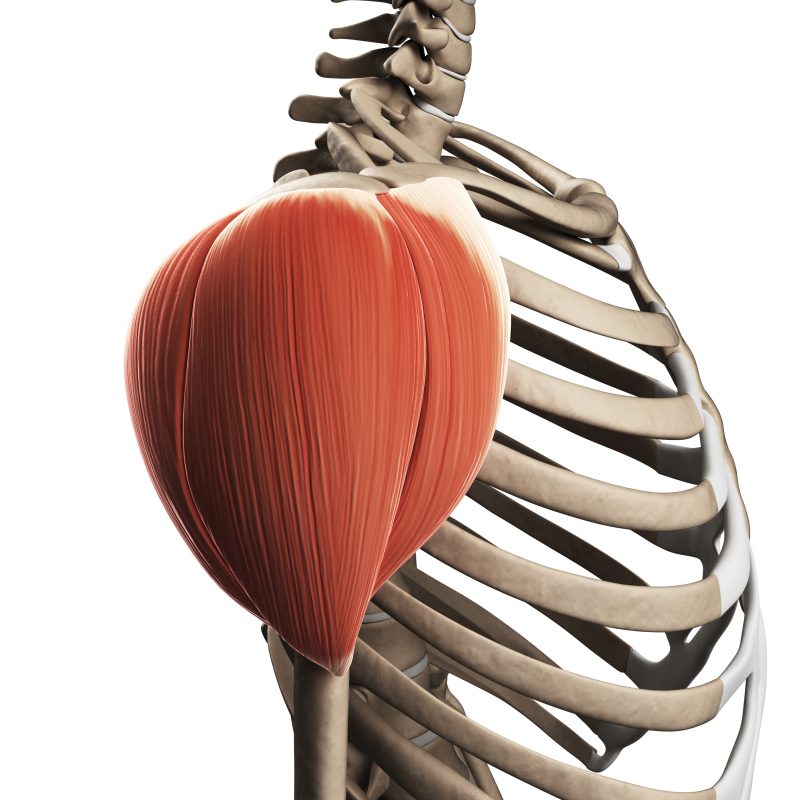
The deltoid muscle, a key part of the shoulder complex, plays a role in activities such as pushing, pulling, and lifting. It also works to stabilize the shoulder joint. The deltoids help foster power and control in various sports-related movements, making it among the primary muscle groups trained by most serious athletes and bodybuilders. In this article we take an in-depth look at the anatomy of the deltoid muscle and its various functions, along with some ways in which personal trainers can create interesting workout programs for clients wishing to add depth and power to their shoulders.
Breakdown of the Shoulder Anatomy
The word deltoid translates to “delta shaped” (oid = shape, delt = Greek letter that resembles a triangle). The deltoid muscle encompasses three distinct parts: the anterior (front) deltoid, the middle deltoid, and the posterior (back) deltoid. Each part bears responsibility for a unique type of movement. The anterior deltoid makes shoulder flexion possible; the middle (medial) deltoid enables abduction; and the posterior deltoid comes into play during the execution of shoulder extension moves.
The deltoid exercises with which strength training individuals have the most familiarity include shoulder presses, lateral raises, and rear deltoid raises. Taking care to execute these moves properly means paying attention to proper stabilization of the joint. The deltoid reigns as the load-bearing primary mover, but the smaller stabilizing rotator cuff also warrants attention. Injuries to the deltoid itself rarely occur; however, the frequency of partial and complete tears in the rotator cuff punctuate the importance of proper shoulder stabilization during heavy lifts.
Muscle Activation Triple-Play
Research scientists have found a way to measure the contributions of various strengthening exercises in shoulder training using a technique called surface electromyography. Personal trainers and athletic coaches use this information when planning the most appropriate exercises for individual shoulder strengthening programs.
When specifically training the anterior deltoid, research indicates that inclined horizontal adductions (i.e., inclined dumbbell flys) generated the greatest muscle activation. For strengthening the middle deltoid, lateral raises associated with internal rotation produced the greatest activation. The posterior deltoid muscle fibers responded best to both pull-ups and TRX (suspension system) inverted rows.
As we often observe in science, however, different experiments can yield conflicting results. One study recruited 13 men who had experience with strength training; researchers recorded muscle activation during maximum isometric voluntary contraction (MVIC) as a baseline, as well as during one set of 12 repetitions with a load of 60% 1RM. This particular study sought to compare muscle activity of the anterior deltoid, medial deltoid, and posterior deltoid in the execution of a bench press, dumbbell fly, shoulder press, and lateral raise.
Unlike the aforementioned study’s findings, the shoulder press presented a significantly higher level of activation for the anterior deltoid. No significant difference existed between the bench press, lateral raise and dumbbell fly. For the medial deltoid, both the lateral raise and shoulder press showed more muscle activation than that elicited by either the bench press or dumbbell fly. Regarding the posterior deltoid, the shoulder press again led with greater activation than either the bench press or dumbbell fly.
Trainers might keep in mind that, given these varying results, each client’s body may likewise differ in response to a particular exercise. As long as we continue to monitor for strict adherence to proper body positioning, any or all of these shoulder exercises will ultimately yield results.
Proprioception Considerations
Within the context of shoulder training, JPS stands for Joint Position Sense, also known as proprioception: the body’s ability to sense the position of its joints in space without visual cues. JPS plays a key role in coordination, stability, and injury prevention, especially in sports that involve overhead movements.
JPS can enhance any traditional deltoid training in the following ways:
- Enhanced sensitivity of muscle spindles leads to better neuromuscular control
- Closed kinetic chain exercises, which engage multiple joints and muscles, can help increase or restore the dynamic stability of the shoulder by facilitating co-activation of shoulder muscles
- Better proprioception allows for greater efficiency of movement, especially important for athletic performance
Trainers may choose from many different exercises when working with clients whose goals center on better deltoid-related JPS. Below we point out several options:
- Mirror Games:
Match one arm’s position to the other, with eyes closed.
- Clock Exercises:
Consciously move the arm in different directions (think of 12 positions in a clock) with eyes closed to improve awareness.
- Wall Slides:
Move arms along the wall, focusing on movement control and muscle activation.
- Open Kinetic Chain Exercises:
Shoulder presses and external rotational moves place more awareness on joint positioning.
What About Push-Ups?
When done properly, the push-up serves as a great compound exercise selection that targets multiple muscle groups, including the deltoids, chest, triceps, and muscles involved in core strength and shoulder stabilization.
As part of a solid deltoid workout, push-ups specifically target the anterior (front) and medial (middle) deltoids. Here we offer a more detailed explanation:
Anterior
These muscles work alongside the pectoralis major (chest muscle) and triceps to lower and raise the body during a push-up
Medial
These muscles contribute to the movement by helping to stabilize the shoulder joint and support the overall push-up motion
Posterior
While not directly targeting the posterior (rear) deltoids, push-ups indirectly recruit rear deltoids as a point of stabilization throughout the exercise.
Optimizing Shoulder Workouts with Tried-and-True Traditional Exercises
When working with novice strength training clients, trainers often find it best — and safest – to stick with simple, traditional exercises in a rep range of 10-15 for 3 sets. Below we present some examples of great exercises for those just starting out on their fitness journey ~
- Military Press
This exercise works the front deltoids and the major muscles in the shoulder region. Stand with feet hip-width apart and hold a dumbbell in each hand. Press the weights overhead until arms extend fully. Slowly lower the weights to the starting position. Repeat for 10-15 reps, three sets.
- Dumbbell Lateral Raise
This exercise can work using both arms simultaneously, or alternating right-left-right-left, etc. Holding a dumbbell, lift arm laterally to shoulder level. Hold briefly, then slowly return to starting point. This move also helps strengthen the rotator cuff. Repeat for 10-12 reps, three sets.
- Single Arm Reverse Fly’s
This exercise works the rear deltoids. Stand with feet placed slightly outside of shoulder width apart. Placing one hand on an upright bench, hinge at the hips and start with a dumbbell in front of body. Laterally raise the dumbbell and retract the shoulder blade with elbow slightly bent, contract, then slowly lower the dumbbell and return to the starting position. Repeat for 10-12 reps, for three sets.
- Rear Deltoid Row with TRX
Hold the handles of a TRX suspension strap shoulder width apart, placing hands in a neutral position. Lean backwards, bringing the torso to a 45-degree angle. Pull the shoulder blades together and downwards, then pull the body towards the hands by bending the elbows. Slowly return to the starting position, fighting gravity with core muscular control. Repeat 10-15 times, for three sets.
When to Train Shoulders: Push Day versus Pull Day
Many personal trainers who work with the same client a few times each week like to create a 3-day split-body training program: Day 1, chest/shoulders/triceps (“push” exercises); Day 2, legs/abs; Day 3, back/biceps (“pull” exercises). When following a push/pull split, training shoulders on a push day tends to yield the best results, since the majority of push-type exercises recruit deltoids, including horizontal pressing movements.
Anterior (Front) Deltoids
The front deltoids contribute to most pushing exercises, including shoulder presses, incline presses, and push-ups. For this reason, the anterior delts may not require additional isolation training.
However, for those clients who want to focus specifically on anterior delts, trainers can suggest adding some isolation exercises to follow the compound movements.
Lateral (Middle) Deltoids
The lateral deltoids come into play during overhead presses and when lifting the arms out to the sides. The lateral delts also assist the pectoral muscle during both flat bench and incline presses.
Posterior (Rear) Deltoids
The rear deltoids, trained during most rowing (“pull”) movements, help to pull/retract the shoulders. Many weightlifters also isolate the rear delts during bent-over reverse flys.
While some prefer to add these at the end of the push day, others choose to include posterior deltoid movements as an adjunct to the “pull” days’ exercises.
Include Sufficient Horizontal and Vertical Pushing Motions
Since the working body engages the shoulders in virtually all pressing/pushing movements, trainers and their clients must pay attention to the overall pushing volume undertaken over the course of each weekly training, to ensure it gets allocated evenly between horizontal pushing (chest dominant) and vertical pushing (shoulder dominant) movements. In consistently training shoulders following chest on push days, overall shoulder growth may stagnate since the training always starts from a pre- fatigued state.
Coaches can combat this by training the chest first on push day 1 and the shoulders first on push day 2. This seems preferable to many athletes than training shoulders on a pull day, which can limit growth in the chest and shoulders due to minimal recovery between sessions. We offer one sample of such a plan below:
Push Day 1 – Chest, Shoulders, Triceps
- Barbell Bench Press: 3 sets of 8 reps, resting 2-3 minutes between sets
- Hammer Incline Chest Press: 3 sets of 8 reps, resting 2 minutes between sets
- Cable Lateral Raise: 3 sets of 12-15 reps, resting 90 seconds between sets
- Cable Front Raise: 3 sets of 12-15 reps, superset with upright row
- Cable Upright Row: 3 sets of 12-15 reps, resting 90 seconds between sets
- Cable Triceps Pushdown: 3 sets of 8 reps, resting 2 minutes between sets
Push Day 2 – Shoulders, Chest, Triceps
- Barbell Military Press: 3 sets of 8 reps, resting 2-3 minutes between sets
- Smith Machine Shoulder Press: 3 sets of 8 reps, resting 2 minutes between sets
- Hammer Chest Press: 3 sets of 12-15 reps, resting 90 seconds between sets
- Machine or Dumbbell Chest Fly: 3 sets of 12-15 reps, superset with chest fly
- Push Up: 3 sets of 12-15 reps, resting 90 seconds between sets
- Barbell or Dumbbell Skull Crusher: 3 sets of 8 reps, resting 2 minutes between sets
Planning Points to Ponder When Designing Programs
The deltoids respond to sets of all rep ranges, and workout programs should reflect this. To create size and strength in the anterior deltoids, try heavy overhead press variations performed in lower rep ranges (<8), while the medial and rear delts respond better to moderate or high reps (8-20) using lighter weight loads. For a complete shoulder workout, vary the reps/loads from week to week.
Shoulders respond extremely well to longer “time under tension” –the amount of time an athlete places a muscle under direct stress during a set. Many variations in exercise modality can extend time under tension, in addition to simply increasing the number of reps performed. Personal trainers might look to include such maneuvers as tempo reps, isometric holds, drop sets, supersets and giant sets. Over time, any of these methods will help foster the development of lean muscle mass in the deltoids.
References:
https://pmc.ncbi.nlm.nih.gov/articles/PMC7706677/
https://pubmed.ncbi.nlm.nih.gov/25594912/
https://pubmed.ncbi.nlm.nih.gov/33312291/
https://pubmed.ncbi.nlm.nih.gov/31319428/
https://pubmed.ncbi.nlm.nih.gov/39593452/
https://www.physiotutors.com/wiki/shoulder-joint-positioning-sense/
Sample test questions:
- The shoulder muscle is comprised of how many major parts, and what are their names?
- According to one research study, the posterior deltoid muscle area responds best to which exercises?
- Can a push-up effectively engage the shoulder muscles? If so, how?
- How does proprioception enhance a shoulder workout?
- What are some basic deltoid movements to include in a beginner’s workout program?






